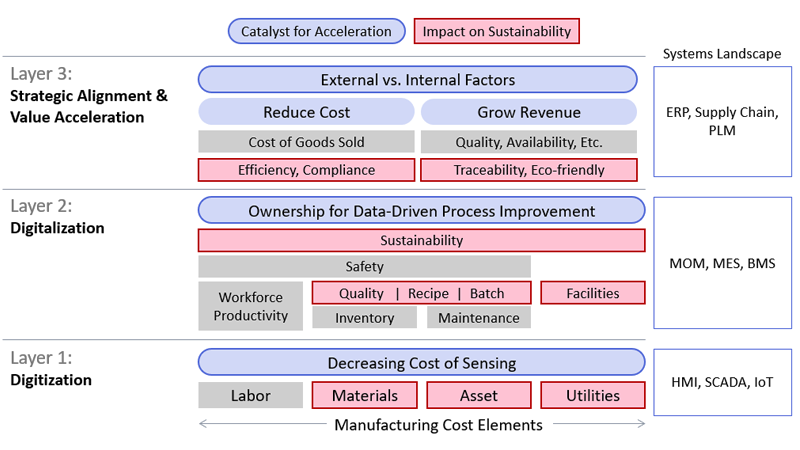The 3 Layers of AVEVA’s Sustainability Handprint
Written by Sree Hameed, Global Marketing Manager, AVEVA
The idea of a handprint (vs. our footprint) is a compelling concept that has emerged from the sustainability conversation. Simply stated, if the footprint represents the (negative) ecological impact of our actions, then the handprint represents our (positive) actions to manage and mitigate this. The goal is to have a net positive effect when all actions are summed up.
AVEVA’s handprint predates the sustainability trend through our clients use of our software to improve manufacturing operations. In the context of the operational excellence journey, the more recent social and environmental imperatives help to further accelerate the sustainability journey of our clients in the consumer goods and manufacturing industries.
To understand how clients build upon their existing digital manufacturing infrastructure to support their sustainability journey, it helps to think of it along three layers as illustrated below:

Layer 1: Digitization is the base layer where data about the physical world gets captured. This layer predates the sustainability trend and has been around for over three decades (enabled by technologies like SCADA and more recently IoT.)
- Impact on Sustainability: If we look at the 4 major cost elements that roll up to Cost of Goods Sold (COGS), Operations has been collecting data related to material use, waste, labor and asset efficiency. Sustainability builds on this data model by adding emissions and effluents, water and wastewater, electricity, gases, etc., to provide a more integrated context (what, where, when, how long, etc.) of the manufacturing operation.
- Catalyst for Acceleration: In the past, a lack of instrumentation has been the main obstacle where investments were deemed cost-prohibitive or unnecessary. The single biggest contributing factor to overcoming this has been the decreasing cost of IoT sensors that has made it economically viable to capture and feed the living digital twin of the physical world.
Customer example: Henkel added 3,500 sensors which provide 1.5 million data points that serves as the digital backbone of their sustainability digital twin.
Layer 2: Digitalization is the layer where analysis, decision making, and action takes place. As such, (functional) ownership plays a key role in driving the business case that determines the digital enablement strategy.
- Impact on Sustainability: Ownership and accountability from execution-level stakeholders is critical to making actionable sustainability-related improvements. As illustrated above, companies may choose to create a Sustainability function within plant operations or expand the responsibility (and scope) of existing functions (and systems) like Quality, Facilities Management and Continuous Improvement.
- Catalyst for Acceleration: While digital systems are a key enabler of the handprint, the right work culture (lean, continuous improvement, empowerment) is vital to success as it lays the foundation for a “see something – do something” mindset to bring about a net positive impact.
Customer example: CLIF Bar used their Visual Factory initiative and Continuous Improvement culture to institutionalize their corporate values and vision for sustainability into daily actions on the plant floor.
Layer 3: Strategic Alignment & Value Acceleration is the layer where vision, executive leadership and governance exist. While supporting and encouraging a culture of innovation and continuous improvement at Layers 1 and 2, it builds upon them to drive momentum and enable scale via a programmatic approach to deliver a step-change in performance.
- Impact on Sustainability: Industry leaders have proven that sustainability initiatives are good for improving both top-line growth (e.g., adding transparency & traceability to the brand promise) and bottom-line profits (e.g., waste reduction.)
- Catalyst for Acceleration: For companies with a reactive posture to sustainability, the growing pressure to act on environmental and social issues can be seen as an external catalyst. For companies with a proactive posture, an effective internal catalyst is to integrate sustainability into their ongoing manufacturing transformation programs via a Center of Excellence that facilitates cross-functional collaboration and standards.
Customer example: AVEVA customers like Olam, Schneider Electric, and Henkel are examples of large companies with mature corporate-wide programs that have successfully integrated their sustainability roadmap into operational activities by digitally enabling their work processes at scale.